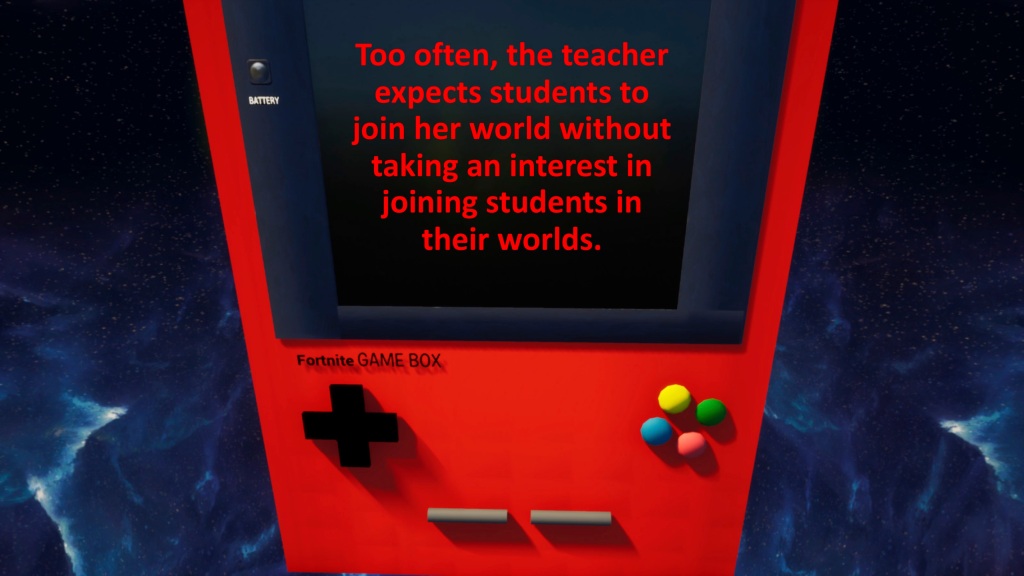Video Games for Relationship- and Team Building
I had the privilege of taking a workshop on Fortnite Creative facilitated by Steven Isaacs. I decided to take this workshop because I knew that many of my students (3rd-7th grade gifted students) were playing Fortnite. The idea of using a violent game during classes was not appealing to me so when I heard about Fortnite Creative, I got excited about learning more.
In Fortnite Creative, players can create structures on a private island and share them with up to 16 players (including the owner) for various multiplayer game modes with customizable rules. Players can place, copy and paste, move and erase objects, including ground tiles, items, and game features. (https://en.wikipedia.org/wiki/Fortnite_Creative)
This means that players can actually build structures on islands along with other players who they invite to join their party.
During the workshop, Steven talked about and show a video of his middle school students’ Rube Goldberg Machines. I love Rube Goldberg machines so the thought of students being able to build one using a gaming platform that were already using was very appealing to me.
Fornite Rube Goldberg Machine Lesson Plan
From Steven’s Fornite Rube Goldberg Machine Lesson Plan:
Who doesn’t love a good Rube Goldberg Machine? Full of humor, wit, and based on simple machines, Rube Goldberg inventions are described as overly complex machines comprised of a number of automated actions to solve a simple problem. I can only imagine how thrilled Rube would have been if Fortnite Creative mode was available in his day. In
this lesson, students will learn about simple machines, engineering, and automation. They will design and build a Rube Goldberg Machine in Fortnite Creative mode.
Some of the NGSS standards Steven listed in his lesson plan included:
- Motion and Stability: Forces and Interactions
- MS-PS2-1 Apply Newton’s Third Law to design a solution to a problem involving the motion of two colliding objects.
- Energy
- HS-PS3-3 Design, build, and refine a device that works within given constraints to convert one form of energy into another form of energy.
- Engineering Design
- HS-ETS1-2 Design a solution to a complex real-world problem by breaking it down into smaller, more manageable problems that can be solved through engineering. (Fornite Rube Goldberg Machine)
(Disclaimer: Fortnite is not supposed to be used by kids under 13. The parents of the students in my class were familiar with their children’s Fortnite use and what we were doing during our Wednesday lunch club.)
I showed them the video, Student Fortnite Creative Rube Goldberg Machine, made and recorded by Steven’s students and told my students their goal was to build something like this. Since the only experience I had with Fornite was what I learned at the workshop, I explained that doing this would be all up to them. They had no problem taking this challenge and running with it.
My Reflection

This went better than I expected. Given that the Fortnite Creative simulates physics, I believe my students learned more about forces and interactions as well as properties related to energy conversion.
For me, though, the bigger benefits were with relationship- and team building. Because our district went remote and given that I teach gifted students at three schools, I combined the 5th-7th graders so we could meet all day on Wednesdays with an hour lunch for the voluntary gaming club. About 6 of my students play during our hour lunch.
Relationship Building – One of the group of students were new to me. Within a half hour of our first class meeting, one of the new 6th grade boys, A., started complaining, asking how long he had to stay. I went to the Fortnite Creative Workshop and the next Wednesday, I asked who played Fortnite and wanted to join a lunch gaming club. A. sparked right up. His attitude towards my gifted class and me took a 180 degree turn. Now, he says that he loves gifted class, engages in all of the activities, and is a strong class contributor throughout all of our learning activities. Since I am a Fortnite Creative noob, he always takes care of me in-world, making sure I am invite to their party, and can find my way around our class’s island for building. I believe this was due to my taking an interest in his life and integrating that into my class. Too often, the teacher expects students to join her world without taking an interest in joining students in their worlds.
The relationship between three students from one school and three from another quickly developed through their shared interest. It’s only been a few weeks and they seem like they have been co-students for years. In fact, they told me that a few of them (from different schools) met over the weekend to play Fornite.
Team Building – Years ago, I facilitated outdoor and experiential team building experiences for all kinds of groups: adult corporate and therapeutic groups for adults and adolescents. As mentioned, Fortnite Creative can be played together by a group. We kept our Google Meet open for ease of communicating during our gaming club. To hear my students working together to build their Rube Goldberg machine and play with iterations of that machine brought me such joy. Their comments were similar to those I heard when I did the outdoor team building activities. They built off of one another’s ideas, expressed satisfactory when iteratios worked correctly for them, and made sure everyone was included in their activities! To get a snippet of their interactions – see below:
Next up for our gaming club – Rocket League (as per my students’ request, of course).

Leave a comment